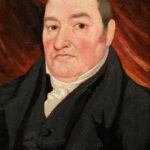When he saw the first daguerreotype around 1840, the French painter Paul Delaroche (1797-1856), declared: ‘From today, painting is dead’. He was wrong, of course, instead painting was liberated to develop creative new ways of exploring, understanding and depicting the world. He was partly right in respect of portraiture, however. Many portraits, the everyday pictures made to hang in the homes of prosperous professionals, merchants, small land owners and the like, were created by painters, who were seen as craftspeople rather than fine artists.
Part two of the BBC4 series ‘The Story of Welsh Art’ sheds light on this. Hugh Hughes (1790?-1863) and William Roos (1808-78) were successful self-taught Welsh artists, who travelled through the Principality seeking commissions to paint prominent members of the community. Hughes’ style was somewhat naïve, Roos’ more polished. Paintings of particularly notable characters might be made into engravings in the hope that print sales would be a good source of income. Both artists painted landscapes as well as portraits.
Hughes painted Huw Griffith of Bodwedda with his Children in 1813. Thirty five years later, just eight years after Paul Delaroche’s apocalyptic statement, Griffith was photographed with his family. Hughes and Roos both died in poverty and obscurity.

